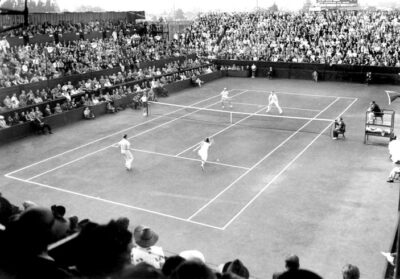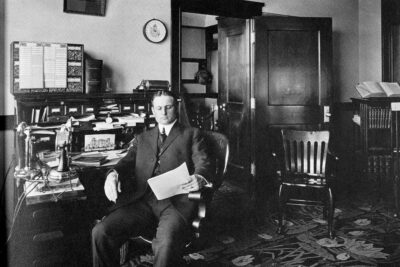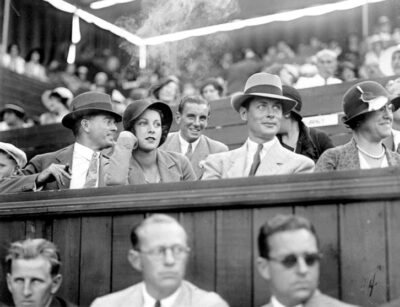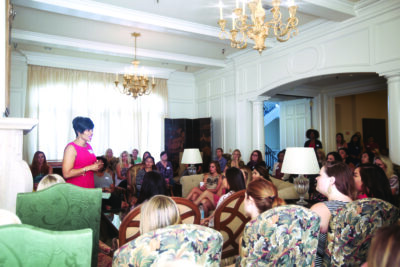Golf club, tennis club, JLLA also date back to jubilant 1920s

CENTER COURT has featured a myriad of stars, from Rod Laver to Jimmy Connors to Pete Sampras.
The roaring 1920s were boom years for many American towns and cities, and Larchmont was no exception. The Los Angeles Tennis Club, Wilshire Country Club and Junior League of Los Angeles got their starts in that jubilant era.
And all are integral parts of the neighborhood today and are thriving well into the 21st century.
Wilshire Country Club at the start of it all?
Some say the Wilshire Country Club set the stage for the stately homes, wide parkways and general bucolic charm of the area.
“It’s such an integral part of the neighborhood. The neighborhood grew up around the golf course,” said club historian Doug Dickey.
When the idea for a golf course was first presented, it had its doubters. There were oil wells that dotted the Rancho La Brea land as far as the eye could see, and a dirt cow path where Melrose Avenue is today.
But by 1917 the oil had dried up, leading George Allan Hancock to suffer a nervous breakdown, Dickey said. Hancock found solace on a trip to Hawaii and in the game of golf.
On his return, when a few businessmen with the vision for the golf course approached him, it must have seemed like a good idea, as he agreed to give a lease for a modest amount with an option to buy. The early success of the 105-acre golf course increased the popularity of the vast, empty land that surrounded it and motivated Hancock to subdivide his remaining land and make his second fortune in real estate.

DEVELOPER George Allan Hancock.
Plan B was a church
The founders of Wilshire Country Club “would be very proud of the club’s first 100 years of progress, especially since the original clubhouse was designed to be converted into a church in case the club failed to be successful,” according to Dickey, author of “The History of Wilshire Country Club: A Centennial Celebration.”
Today, the club hosts the esteemed Ladies Professional Golf Association (LPGA) and its Hugel-Air Premia LA Open, when many of the world’s best women golfers descend upon the Hancock Park course, which certainly would be impressive to the group of businessmen who incorporated the club on Sept. 25, 1919.
Memberships were open to women from the start, although they didn’t initially have voting rights or financial interests in the property. But that would change.
In the early days, there were celebrities on the course, (of course) with its proximity to Hollywood. Actress Katherine Hepburn and her beau Howard Hughes played golf secretly near their home at the club’s eighth green.
The club’s third and current clubhouse was completed in 2001 by architect Scott Johnson and the Johnson Fain firm, which would further remodel the building in 2008. The latest rendition was built with the first building’s California Mission style in mind.
Norman Macbeth Invitational
The club’s centennial celebrations were held in 2019 with great fanfare and fireworks. The club’s esteemed 72nd annual Norman Macbeth Invitational Tournament, however, was moved because of the pandemic this year from its traditional Memorial Day weekend slot to Labor Day weekend.
The invitation-only event is considered among the finest in all of Southern California and is held in honor of the club’s original golf course designer, club manager Daniel Enzler said.
The tournament’s winner last month was the team of Scott Krivis and Pablo Suarez of Valencia Country Club.
“It’s a great neighborhood,” said Enzler, who was previously at the Brentwood Country Club. The Swiss native is familiar with the area, having visited the Switzerland consul general’s residence many times before Switzerland sold that Windsor Square home.
Home of Champions — Los Angeles Tennis Club

CELEBRITIES often lined the grandstands. Notables included Clark Gable, Carole Lombard, Gary Cooper and Charlie Chaplin.
A love match is at the genesis of the Los Angeles Tennis Club, whose 101-year history also teems with sport legends and movie stars.
“In its heyday, we were the place where the tennis stars mingled with the celebrities,” said Colleen Connors, director of membership at the club.
But before the stars and the crowds, the clubhouse and multiple tennis courts, there was May Sutton, a teenage girl who was determined to marry a man who could beat her in the game of tennis.
Not an easy feat, as the 17-year-old Sutton was the first American to win the Wimbledon singles title.
Apparently, tennis champ Thomas Bundy did win at least one game with Sutton, as the couple was married in 1912.
Bundy, a subdivider of Miracle Mile, was among a group of businessmen and amateur tennis players who would, on the heels of another pandemic — the 1919 Spanish flu — make an offer to George Allan Hancock to buy five-and-one-half acres of his vacant land for $11,000.
The Tennis Club was founded in 1920 at 5851 Clinton St., and Bundy was its first president.
Everyone was an amateur tennis player in those days and would remain so until the 1960s when some players began receiving salaries.
But that’s not to question the Tennis Club’s royal lineage: Bundy was a three-time winner of the U.S. doubles championship, and May Bundy won Wimbledon not only in 1905 but again in 1907. The power couple and their daughter, Dorothy “Dodo” Cheney, were among a long line of members to enter the International Tennis Hall of Fame.
When tennis legends played the courts, including the famous Center Court (christened the Home of Champions), Marlene Dietrich, Clark Gable, Errol Flynn and other stars cheered from the box seats.
Until the 1980s, the Pacific Southwest Tournament — the fifth largest match in the world — was held here, with Billie Jean King and John McEnroe swinging racquets before sold-out crowds.
Times changed when the Olympics came to Los Angeles in 1984. The club’s stands weren’t large enough, and so the tournament was moved to a new facility at UCLA.
According to LATC historian Patricia Henry Yeomans’ book, “History and Heritage of The Los Angeles Tennis Club 1920-1995,” LATC continued to host significant matches, including Southern California United States Tennis Association events for juniors that featured the likes of Tracy Austin and Serena and Venus Williams.
While the Tennis Club no longer is the center of the tennis world in the west, there are no regrets.
What’s left “is a nice neighborhood club. It’s an extension of the Greater Wilshire Hancock Park area,” said Connors.
“We feel so honored by this history we’ve been given, but looking ahead, we’re becoming more of a family club.”
Zachary Gilbert, a sixth-generation Californian from a prominent tennis family, agreed.
The club’s new director of tennis, Gilbert is charged with leading the club into the future.
In his younger days, when his father coached Andre Agassi, Gilbert spent time with the tennis pro and was inspired by Agassi’s philanthropic work. Gilbert hopes to bring that same spirit to the Tennis Club.
While many aspects of the planned centennial celebrations are still on hold because of the pandemic, Gilbert says he hopes to celebrate next year. “When we do it, we want to do it right.”
Meanwhile, with all that’s been going on, the club has served as a welcome oasis to its members, he added.
‘Super-charged’ Junior

JLLA PRESIDENT-ELECT Joy Williams at a recruitment event.
League of Los Angeles
Since 1925, the members of the Junior League of Los Angeles (JLLA) have been a powerful voice for those whose voices have often been silent throughout history.
“Women and children have been our focus since the beginning,” said current JLLA President Sarah Christian.More than 2,500 kids were impacted in a good way by JLLA programs in the past year alone. And throughout its illustrious history, the group has launched and supported more than 100 projects.
Its members learn leadership skills and in turn become advocates for issues they are passionate about, including education and foster youth. The latter issue is close to Christian’s heart and one she has followed in her 10 years with the JLLA. A litigator by profession, she began her term as president in June.
Christian joined the League, because “I wanted a formalized way to volunteer … and loved the opportunities of serving. … It really has given me a lot of joy.
“The leadership training is what sets us apart. Members find a passion in the League, and then they go from there. We like to think we create super-charged volunteers,” said Christian. (JLLA president-elect Joy Williams will take the reins in June, 2022.)
Members do hands-on volunteering and work on government initiatives and policy changes. But whatever the scope, be it teaching campers outdoor skills, helping foster youth learn to budget or working on Senate Bill 1065 to provide increased benefits for homeless youth, members hope to make lasting changes.
As they approach their centennial in 2026, they are considering issues to highlight going forward, including those that have been hard-hit by the pandemic: homelessness, food shortage and domestic violence, Christian said. “We’re trying to help create curriculum to change the landscape in Los Angeles,” she added.
JLLA 1925 beginnings
While the group officially incorporated in 1926, a group of local women (including Pauline Schoder, mother of the Chronicle’s publisher) gathered a year earlier in the living room of one of the founders to conceive their first project: a 12-bed children’s convalescent home. It was to become part of Children’s Hospital Los Angeles.
Today, members of the Los Angeles chapter — which is part of The Association of Junior Leagues International — meet online. They hope to return soon to their headquarters at the stylish French Regency building they own at 630 N. Larchmont Blvd.
The building is named the Rainey House after 1943 League President Marjorie Hamlin Rainey, whose bequest helped fund the building, which opened in 1995.
Previously, the League’s office locations included the Beverly Hills Hotel and the Original Farmers Market. Its major annual fundraiser, the Harvest Boutique, is a gala affair with boutique vendors, a silent auction and luncheon, which support JLLA’s many community projects and partners. This year, the event is scheduled for Dec. 12 at the Skirball Cultural Center. “Hopefully, it will be in-person,” said Christian.
Category: Real Estate
